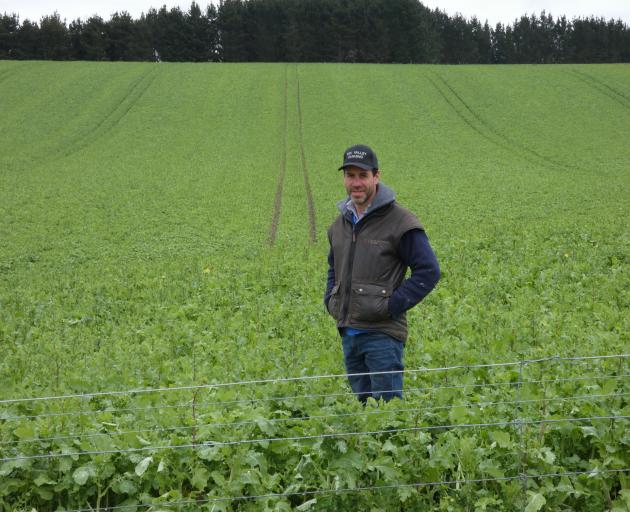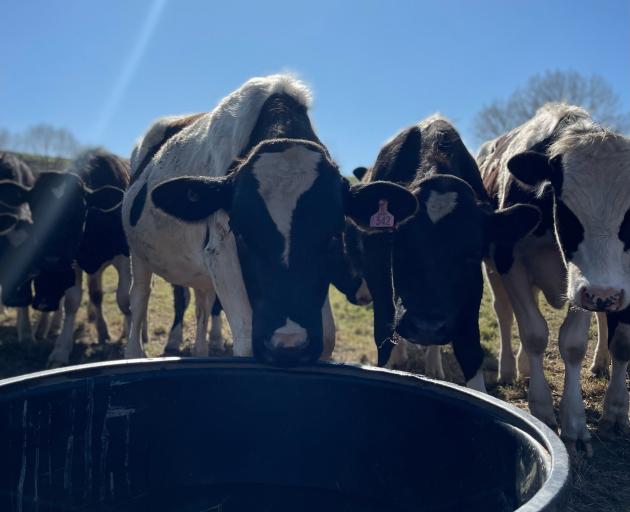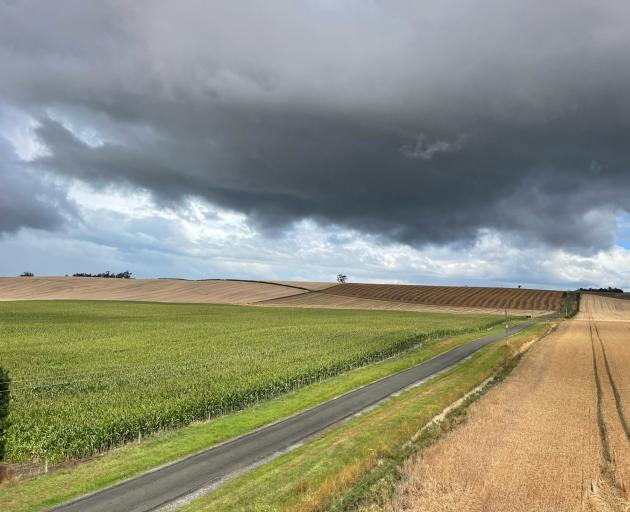
Peter Hewson steps out of a red truck to get a lay of the land.
At a surface glance, the view takes in the mixed cropping farm’s rolling hills and flats in South Canterbury’s Esk Valley.
Peering out, he sees a deeper interpretation of its contours and underlying structure of heavy Claremont soils. Nuanced shades of subtle brows and shallow depressions producing fertile and less fertile folds paint a picture, to those in the know.
The 37-year-old farmer points to a snaky line in the lower reaches of a paddock where a crop has turned pale yellow, yet on each flank flourishes. This is where ground moisture collects and sulking barley unhappy with waterlogged roots has protested by turning colour.
To the right, a shelter belt overlooking this scene once provided breeding ewes a break from the wind.
They will likely be toppled as the flock is gone, replaced by trading lambs and more cropping.
Old man pines soaking up water in the root zone are a hindrance and shade out another feed barley crop on its immediate periphery, spelling lost income. As the crop extends beyond its shadows, growth rates pick up and yields multiply.

On one half lies undisturbed soil after a direct drill pierced seed into the residue of the previous crop.
Yet the other half has clearly been turned over with one cultivation sweep followed by a pass of the drill.
Mr Hewson said this was a trial he was carrying out to find which system worked best for the crop after compact testing its soils.
Before settling on this side-by-side comparison he asked followers of their Esk Valley Farming page on Facebook to pass on their opinion.
"About 40% were in favour of drilling and 60% in favour of cultivation so I thought we’d try both," he muses as he closes the door and heads home. "This way we can see for ourselves which works best."
He and his wife Nicole are the fourth generation of Hewsons on the 475ha dryland farm.
The family has lived and farmed in the district for more than 100 years.

The latest generation returned to the farm in 2016.
"I was never under any pressure to come home because they had a good relationship with the guy who leased it here. So the opportunity was here if we wanted it. I did a panel beating apprenticeship then did earthmoving for quite a few years. Then Mum and Dad said if farming is what you want to do why don’t you go work for a guy and see what that was like."
Mr Hewson, who grew up with early memories of breaking ice on water troughs and sitting on the combine harvester with his father for hours, took on the advice.
For a year he worked for Murray Turley and then for owner-operators Geoff and Joy Hayward.
Returning home, the plan was to lease the farm for five years and sell the machinery and leave in the event it wasn’t for them.
Instead, they bought the farm outright from their parents last year.
Passing on the farm to the next generation was seamless with his sisters wanting to see the property kept in the family.

They aim to take the same approach when the next generation takes over.
"We have big shoes to fill," Mrs Hewson said. "Peter’s parents have set everything up and made it easy for us to take over so it’s a responsibility on our shoulders to do the same for the next generation — our [three] daughters. Whether they want to be farmers or might want to lease it out, we will see. They [Peter’s parents] did an amazing job and we are grateful and need to make sure we do the same."
A veterinary nurse before children arrived, she now runs all the accounts for the business, including the payroll for full time employees Jordan Crawford and Nick Stephenson.
Growing up around horses, livestock and farming in an "idyllic childhood"on a large lifestyle block near Timaru, she transitioned easily into day-to-day farming.
"It’s just the best childhood you can imagine for our daughters. They are driving motorbikes and riding ponies and help out on the farm."
Mr Hewson senior ran a mixed cropping operation with breeding ewes initially and a techno bull system for Friesians on a grid of grazing cells.
This was continued when the farm was leased and for another year by Mr Hewson until he found it restricting.

This follows a policy of cattle only spending one winter at Esk Valley with no big animals held over winter. This helps prevent soils from pugging.
In the first few years they lambed 1100 ewes before realising this wasn’t for them and a simpler system worked best.
Exiting ewes were replaced with finishing store lambs obtained from as far as Southland and the North Island. They’re brought in during and after the harvest with numbers dependent on how much feed is available.
Typically about 3000 lambs are taken on with the aim of a minimum kill weight of 22kg by the time they leave the property, from May to September. Up to 1500 hoggets from a nearby farm are contract grazed and gone by Christmas.
Mr Hewson said he enjoyed fattening and feeding stock and seeing them reach their full potential by making finishing weights.
If forced to choose, cropping would come out the clear winner.
"In our first year we put in 300ha of crop. We arrived in January and had no income for that first year for crop. Now we’re in the routine it’s still difficult," he laughs, "as payments vary throughout the year".

About 85% of the crops are autumn-sown with spring-sowing reserved for milling wheat, peas, beans and maize grown for silage.
They’re still struggling to find a good spring break crop with a decent payback.
About 80ha in permanent pasture is generally in paddocks less favourable for cropping. They go into pasture for five years before being planted back into crop.
"I just love drilling the crops and seeing them come up. It’s really special. Before Nick [Stephenson] came along, I could have cultivated, drilled, fertilised, sprayed and harvested a paddock. While I can’t say I have done all that now, it is really satisfying to see the whole process.
His father dresses the grass seed and puts it in a bag and then it is loaded into a container.
"So we are involved right through. It’s good harvesting and seeing it going out the gate in a truck and know you are getting paid."
The dressing plant was put in by his father in the top yard in 1988.

They count themselves fortunate to have good staff with Mr Crawford now into his fifth year and Mr Stephenson working three summers on the harvest before becoming a full timer.
A full team has been able to carry out farm work beyond daily business, ripping out gorse fencing the past three winters, putting in drainage and maintaining the property.
Mr Hewson tries to be the best boss he can.
"I’ve worked for a lot of people, so when I came home and employed people I knew how I wanted to be treated. So I listen to them, don’t lose my cool and my way is not the highway. Jordan [Crawford] oversees a lot of the stock and I take on board what he says."
When it comes to preparing paddocks and planting crops he has a flexible mindset, pointing out every year is different.
They have direct drilled and minimum tilled paddocks in the past as well as burning crop residues and cultivating fields when needed. Maize is strip tilled and everything for winter — oats and brassicas — is direct drilled.
"Some people have this marvellous rotation, but I don’t really have a fixed rotation. I do have three 21ha paddocks which I put into rotation, but the rest of the farm is quite flexible where it goes. It’s hard to get break crops and quite a juggling act without oil seed rape which we don’t grow. Usually, we have 30ha of brassicas and we have 6ha this year so you have to scramble sometimes for break crops."

But his rotation in the three paddocks is autumn wheat, autumn barley and brassicas drilled in January, which lambs eat over winter.
"Last year I grew faba beans because I needed to get back into autumn wheat without growing too much wheat on wheat. So we are trying that again this year and see how it goes."
Dryland feed wheat yields average 9.5 tonnes to 10t to the hectare and barley 8-9t.
Good grass seed yields are achieved even when it is dry, while 30ha of maize averaging 19t for silage the past three years was topped by 22t last year.
Maize helps free up the soil and provides an income source arriving at a different time of the year. It is sown after a grass seed crop with soils prepared by strip tilling at 750mm spacings. A ripper leg leaves a slot for precision planting with the ground in between left untouched.
Clay-based Claremont soils hold water, to the extent their accountant once told them they would be better off investing in drainage than irrigation.
So they farm what’s before them, making the most of ground moisture and because their farm is sheltered the most part from nor’westers harvesting often has to stop at 9pm as dew arrives, preventing the combine harvesters from going through the night.

Mr Hewson has proven he’s a quick learner, backed up by him being named Cereal Grower of the Year last month at the New Zealand Arable Awards.
Mrs Hewson said the win was well deserved.
"He is very fussy about his cropping and is always on top of everything all the time to the utmost standards. There is a flow on effect because his team know what his standards are."
He confesses fussy is an apt description, to the extent that family trips used to come second as he was reluctant to leave the farm when spraying needed to be done.
More lately he’s eased up on this after training the younger team member to take on the role.
"No farmer pats himself on the back and says he deserves an award and you just do what you do. Obviously I didn’t nominate myself, someone else did, and it’s an honour for someone to single me out to say I’m doing a good job and the judges to agree especially when there were other top farmers."
He’s open to introducing technology when it pays off.

"So that means we aren’t blanket spreading and then that leads to variable rate spreading with the fertiliser spreader."
They do the spreading themselves with auto-steering tractors making light work of following GPS routes.
Nitrogen is delivered to paddocks where it is most needed by being guided by satellites tracked by a website capturing the biomass of crops via overhead images.
The only downfall with this is when overcast weather prevents images being taken and a cloudy spring can prove problematic.
A Trimble app logs all of their inputs on smart phones with the information shared to team members so everyone is on the same page.
After a job is completed, details such as time spent and machinery used is compared with yields and overall costs to calculate the gross margin at the end of the year.
"Rolling country is quite easy to see the variation, ... so we can put more in some areas and less in others where there’s sunny faces and south faces. We don’t want to go all out when we don’t have to, because that hurts our own pockets and environmentally it is counter-productive. The rabbit hole of technology is massive in the farming industry, which can get quite intricate, but I would like to get an N sensor — they’re about $40,000 to $50,000 and that leads to variable rate drilling so you can vary your rate over paddocks and you can put variable rate growth regulators in so it’s endless."

As for the future, they want to continue to improve the business.
In 2016 irrigation was considered, but they were advised they would have to change their farming system to make it pay.
Dairying wasn’t for them as they like what they are doing — so the decision was easy.
"We don’t have a 10-year plan of where we want to be, but I still leap out of bed each day and am always keen to work so I don’t want to change anything at the moment."
That’s not to say they aren’t open to new ideas.
Running contrary to a simple sheep system is Mrs Hewson’s flock of 50 Valais Blacknose sheep, expanding from 19 ewes in 2019. Another 60 to 70 are lambs on the ground.
About 10 ewes and two rams are purebreds and she’s breeding the rest up to increase their pedigree.

A new sideline for her is a newly fenced off area of 175 peony roses likely grown for tuber sales once they become established.
Somehow they find time in their busy lives to give back to the community. Mr Hewson is the arable vice chairman for Federated Farmer’s South Canterbury branch and president of the Sutherlands discussion group, while Mrs Hewson is president of the Esk Valley kindergarten.
Another side interest is posting the farm’s progress on Facebook and Instagram pages, where Mr Hewson’s skills as an amateur photographer can go on view.
The social media is for a bit of fun, but it showcases farming to townie friends and other followers. Ground-level and aerial images by drone show changing seasons, livestock scenes and farming machinery at work. The drone also comes in handy for surveilling crop progress.
He’s not afraid to put up his mistakes and failures — such as a loss-making pea crop or a windrowed rape paddock ready to be harvested — until hail arrived — to show farming isn’t always red roses.
Their motto was to have an immaculate farm and always leave something for the next person to make a dollar, he said.
"It’s about finding the right balance between being sustainable and profitable. We want to be proud of our farm and happy to show people around no matter the time of year. First impressions are the last and a tidy yard has a flow on effect for the standard of the rest of the farm."















